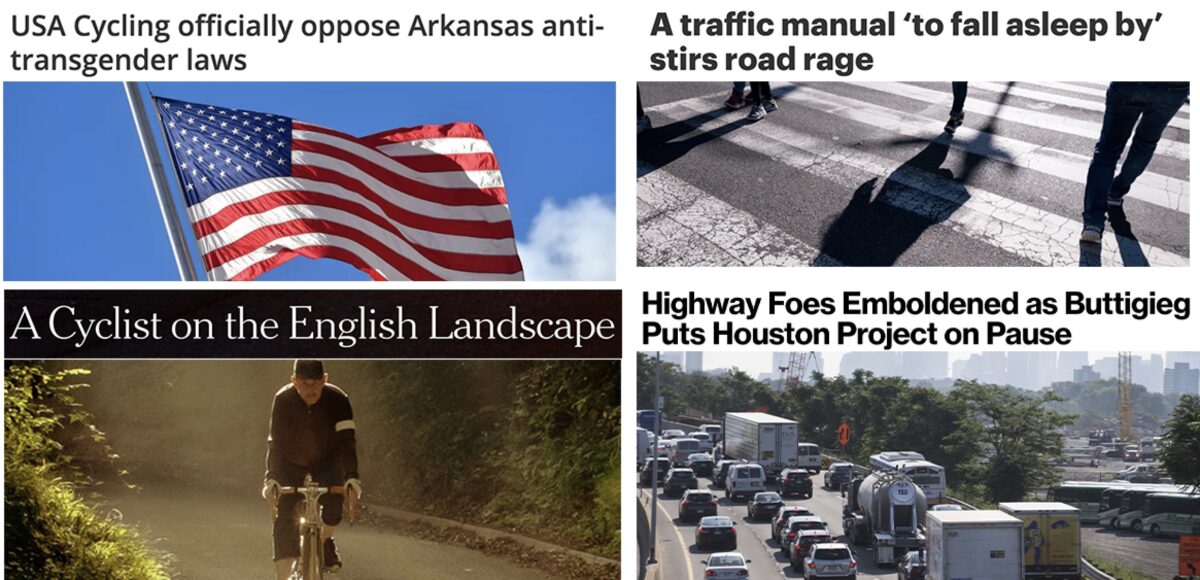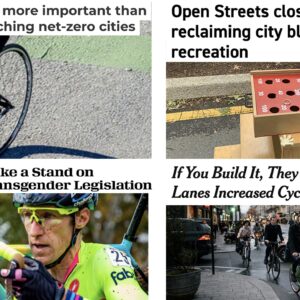Happy Monday BikePortlanders.
Here are the most notable items we came across in the past seven days…
Routine traffic stop: A Black man named Daunte Wright died Sunday after he was shot by a Minnesota police officer. The man was pulled over for a minor traffic violation and was in the process of being arrested for an outstanding warrant prior to the the incident.
MUTCD’s 15 minutes of fame: The Manual on Uniform Traffic Control Devices (MUTCD), which is the federal road engineering bible that dictates everything from sign design to speed limit rules is undergoing a major revision and the fight between advocates on the outside and inside over how much it should change has reached national political drama status.
Advertisement
Learn more and speak up: The National Association of City Transportation Officials (NACTO) has an excellent overview of the MUTCD issue and has all the links and info you need to comment to the federal government.
Get inspired: A photo essay from a travel photographer who cycled across England and captured a series of “poetic self portraits” is sure to get your legs and tummy tingling for adventures.
Freeway fight goes national: Dozens of activist groups across America have realized they have something in common: A strong dislike of freeway expansion projects and a sympathetic US DOT Secretary.
Tragedy and a tweet: A man killed while bicycling in D.C. had tweeted about how dangerous road conditions are in the area just hours before the collision.
USA Cycling on Arkansas: America’s governing body for competitive cycling has issued a statement that supports athletes who wish to boycott Arkansas events because of that state’s anti-transgender law.
Advertisement
Crash not accident: The City of Chicago is taking steps to remove the word “accident” from their municipal code on account of it being inaccurate and harmful to progress on traffic safety issues.
Speeding Tiger: Color me shocked on two fronts to this sad story: Superstar icon Tiger Woods was speeding recklessly prior to his serious crash in California last month, and (of course) he won’t be cited.
Sign of evolution: For the first time ever, the vaunted National Transportation Safety Board has put a priority on the safety of humans who exist outside of large motorized vehicles.
Eff you-Vs: Just how screwed up is our infatuation with SUVs? According to Grist, “If all SUV drivers banded together to form their own country, it would rank as the seventh largest emitter in the world.”
— Jonathan Maus: (503) 706-8804, @jonathan_maus on Twitter and jonathan@bikeportland.org
— Get our headlines delivered to your inbox.
— Support this independent community media outlet with a one-time contribution or monthly subscription.







Thanks for reading.
BikePortland has served this community with independent community journalism since 2005. We rely on subscriptions from readers like you to survive. Your financial support is vital in keeping this valuable resource alive and well.
Please subscribe today to strengthen and expand our work.
Another interesting piece of news: France is banning short domestic flights that have passenger train routes.
Unfortunately, that will only impact a handful of routes, but I suppose it is a start. We flew to Amsterdam from Portland a few years ago and transferred right at the airport onto a train to Berlin. It was very easy, and I preferred being on a train for the connection. I hope we can find opportunities for this in the United States.
I believe Baltimore-Washington airport has a passenger rail line station in the terminal, part of the mainline BosWash Amtrak line, maybe Newark Airport in NJ too. There are plans to run the mainline track into Charlotte-Douglas airport but no funding yet.
The BWI station isn’t in the terminal; you have to take a bus ride to get to it, but it’s not so bad. In Newark you take a little automated people-mover to the station (it’s closer than the BWI one though). Miami and Ft. Lauderdale airports are both on a regional South Florida rail line (not Amtrak).
It’d be nice if airports were directly on intercity rail lines, but there are quite a number — Chicago O’Hare, Philadelphia, Seattle, Minneapolis, Reagan National and soon Dulles — that have local rail connections to the intercity rail stations. Given that airports are usually well outside city centers and rail stations are usually downtown, that doesn’t seem so bad.
And outside of Boston-DC and *maybe* Seattle-Portland and Chicago-Milwaukee, intercity rail in the United States is often neither faster nor cheaper than other modes, including air and bus lines. Major cities, especially west of the Mississippi, are also way more spread out than in Europe.
(I say all of this as a big fan of long-distance rail travel.)
About SUVs: Ever look up from your handlebars to see who is driving SUVs? I see women driving them 70-80% of the time. Why? I venture to say that it’s because women are more safety-conscious than men are, and they have made a *logical* decision to drive what they deem to be the heaviest and therefore safest vehicles (what was the title of that book about “the SUV arms race”?).
If Vision Zero were an actual thing and people didn’t have to worry so much about being killed and maimed on our streets, would women, in particular, buy fewer SUVs? Or should they just be legislated out of existence? (the SUVs, not the women).
Fred, and do not forget the “mom taxi” domestic rideshare daily tasks…in addition to your points…though the monster pick up trucks have recently taken over the SUV on the pantheon of excess vehicle per task / VRU safety impact
It’s basically an arms race. 20 years ago, parents were driving station wagons and minivans. Now those aren’t considered safe enough because SUVs have taller bumpers. So now, most parents are driving vehicles that are basically just lifted minivans (still a car based chassis) without the convenience of sliding doors. Oh, and don’t underestimate the “utility” value that people are placing on vehicles that never go offroad or drive in the snow. People pay for image.
I’ve often wondered if the SUV craze is a result of the perceived aesthetics of the humble mini-van. I think part of the reason they have been replaced by SUV’s is that the SUV’s marketing is mostly about masculine, powerful, all-terrain awesomeness. In contrast, nothing says “domesticated parent” like a mini-van. They just aren’t. . . sexy. In the whole world of “men’s rights” and all that, a consistent theme is how all things manly are being taken away from men. But gun advertising, truck advertising, and SUV advertising suggest to men that their purchases can solve that (one famous gun ad says “Consider your man card reissued”).
–
And then, of course, since the man in a hetero dyad might be swayed by that marketing, some women will end up using them to drive the kids around!
The MUTCD fight is probably the most important effort to reform SUV/truck-centric transportation policy in many decades.
Is there a local group that is supporting this fight (e.g. a letter/comment campaign or direct action)?
I am biting my tongue as I write this….We found the gold:
“competitive bidding with equally suitable unpatented items”
Can this means: increasing the use of high tech features for safety because we have federal authority to break the patents to make profit over safety features.
Does this mean the federal government can copy/modify the AI safety software in cars and use for public good.
ACK? Anybody have any legal thoughts? Alan…. anybody….
Yeah…that pro-AV revision is really terrible. Like TNC*s, autonomous vehicle technology is expressly designed to be a techno-capitalist poison pill for public transit.
One of the many reasons I have zero interest in supporting most active transportation orgs is that they are riddled with libertarian urbanists who fawn over TNCs and AVs with complete disregard for their negative externalities.
*e.g. Uber and Lyft
Thanks for linking to the excellent story about the MUTCD. Everyone should comment (by following the NATCO link).
I love how the guy liked criticism of the MUTCD to “cancel culture,” which is the new “Get out of jail free” card for the right wing.
Also loved the comment about using the 85%-percentile speed to set speed limits: “It’s like setting kids’ bedtimes based on when 85% of them say they want to go to bed.”
The MUTCD dictates street signs and lane markings.
The AASHTO Green Book (another federal-ish engineering been) dictates “design speed” of roads. Typically they are required to be safe for travel at 10 mph faster than the planned posted speed limit.
State legislation in many states (Oregon and California included, I think) dictates that it is illegal to post a speed limit lower the the [?]th percentile speed of people on the road. Something like “is 50% of the people are going 35mph or faster, the road can’t be posted at less than 35 mph.”
Which makes, of course, it difficult to design a road for XX speed limit, and not have pressure to raise the speed limit 10 mph after the road is built.
Just a minor clarification, and a vexing conundrum that is the result of two different well-intended legislative bodies’ codes’ interaction with each other.
Ted Buehler
Most states have found work-arounds for the 85th percentile rules and 10 mph over, which as you say is nearly universal policy. My favorite is in West Virginia, one of three states in which the state DOT owns and maintains all county public roads. It’s so far the only state that I’m aware of that rates highway curves to exactly the posted speed limit – if you go 10 mph over, you will drive off the road into trees or a cliff and likely die – which is a quick and effective way of using the roadway design to remove scofflaws from the gene pool. Clearly not Vision Zero.
“Engineering Speed Limits
The MUTCD is the national standard for all traffic control devices on roads open to public travel. It requires that speed limits be posted in increments of 5 mi/h (8 km/h) and that speed limits in speed zones be based on an engineering study and analysis of free flow speeds (speeds that are unimpeded by other vehicles, stop signs, signals, or inclement weather).
The MUTCD recommends that agencies set speed limits within 5 mi/h (8 km/h) of the 85th percentile speed of free-flowing traffic. The 85th percentile speed is the speed that 85 percent of drivers travel at or below and is one of the best indicators of a reasonable and safe speed. According to FHWA’s report, Methods and Practices for Setting Speed Limits (FHWA-SA-12-004), motorists who drive faster contribute disproportionately to the risk of crashes. Setting a speed limit 5 mi/h (8 km/h) higher than the 85th percentile speed will make a few additional drivers legal, but setting it 5 mi/h (8 km/h) lower will make violators out of nearly half of all drivers.”
https://www.fhwa.dot.gov/publications/publicroads/13sepoct/02.cfm#:~:text=The%20MUTCD%20recommends%20that%20agencies,a%20reasonable%20and%20safe%20speed.
Regarding “Eff you-Vs”: perhaps the new punch line is “How many cyclists does it take to offset SUV drivers?” or
Or maybe the authorities decided to conserve scarce resources given that no one else was injured and that the horrific injuries Woods suffered were punishment and deterrent enough.